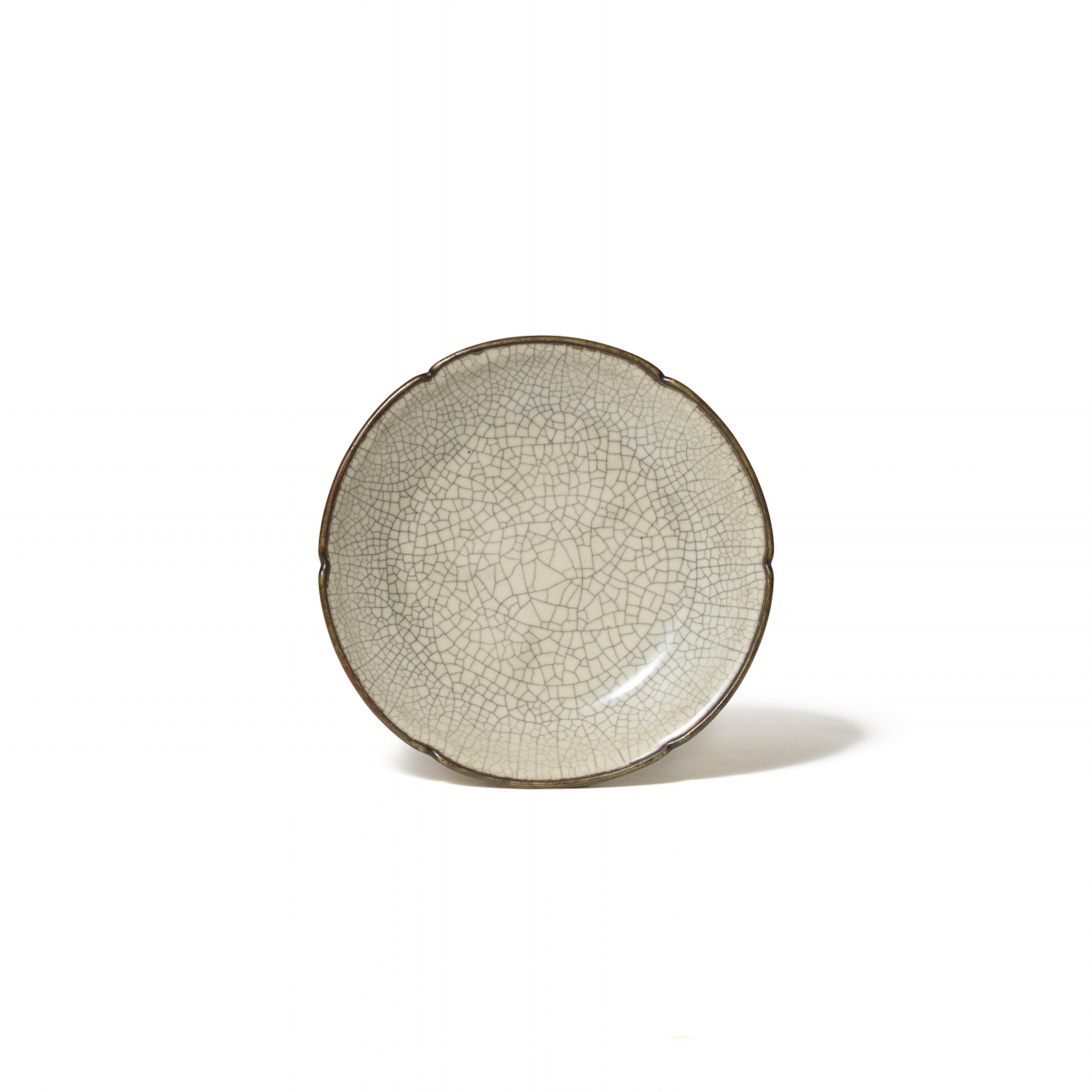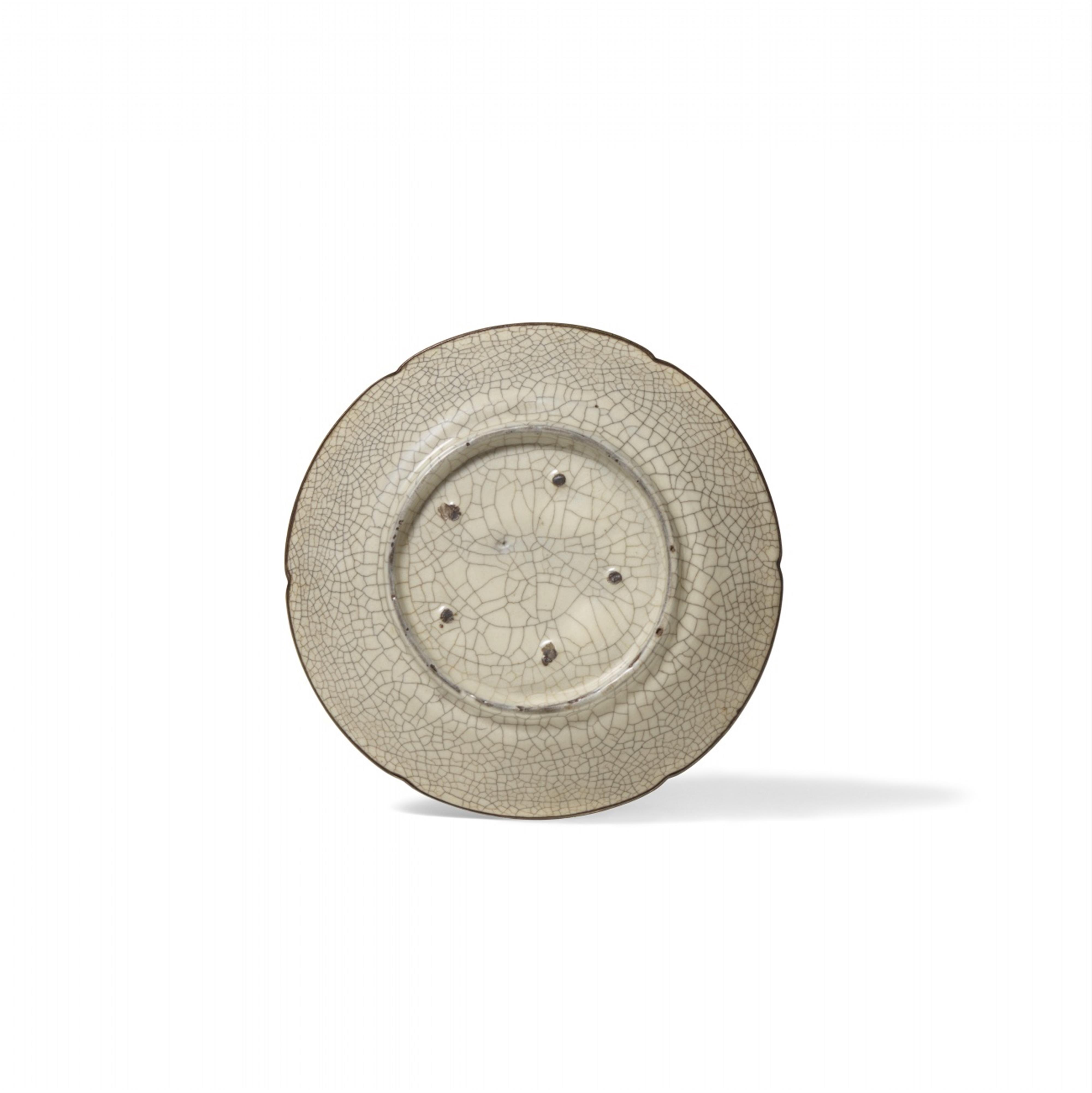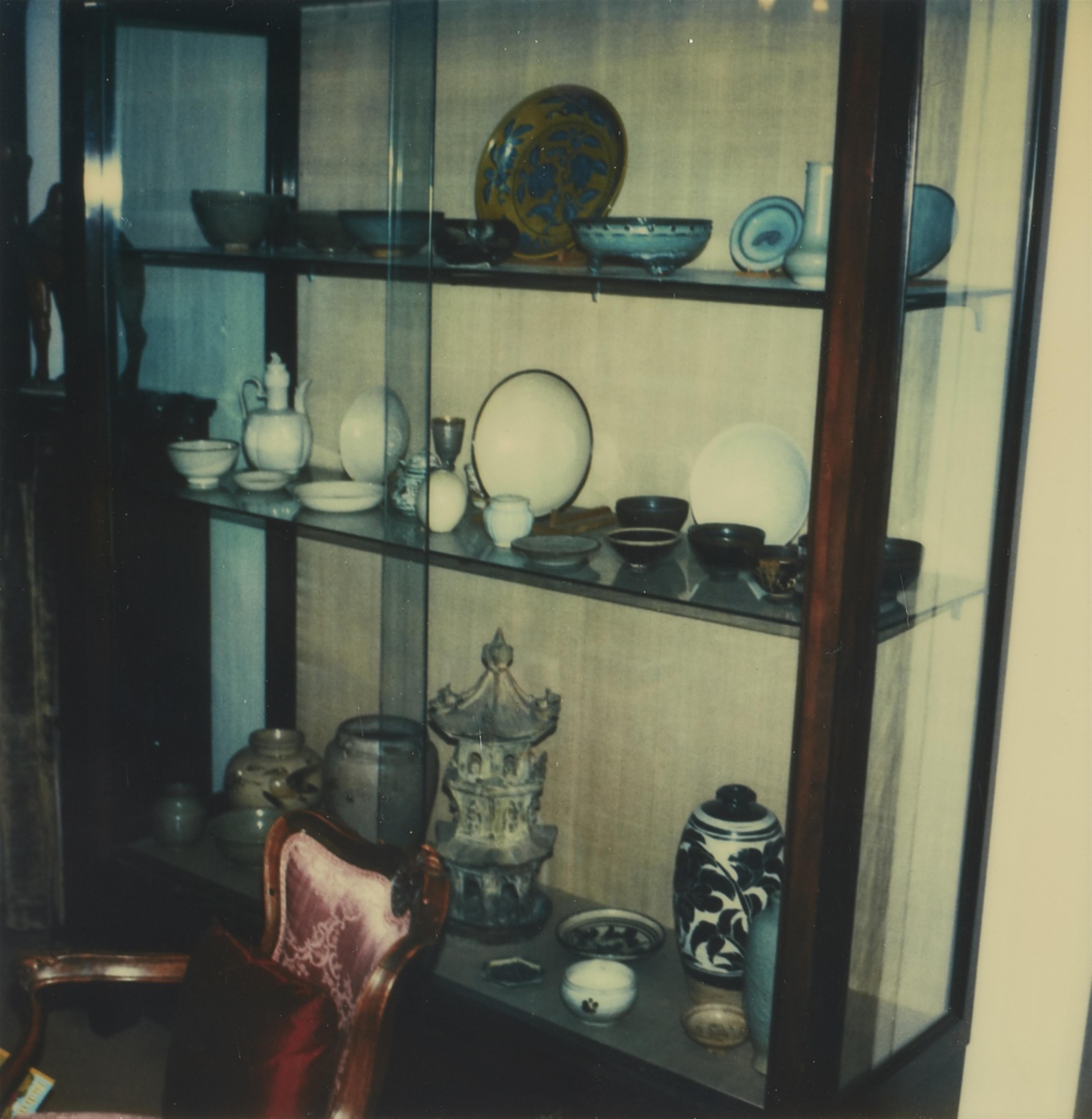A very rare and magnificent Ge foliate dish. Southern Song/Yuan dynasty (1127-1368)
With flaring sides rising to a notched rim divided into six lobes, on a recessed base, covered overall with a lustrous glaze of pale and creamy grayish-green tone suffused with a wide network of crackles stained black (tiexian, iron-wire) and a very slight crackle stained golden brown (jinsi, golden thread) below the rim. Six spur marks to the base exposing the dark brown body. Metal-mount to the rim.
Diameter 14 cm
Where exposed, the body has turned reddish-brown in firing.
A rare hibiscus-shaped Ge dish
The craquelée stoneware of the southern Song dynasty (11277-1279) has been surrounded by an aura of secrecy for hundreds of years. Connoisseurs of the Yuan and Ming periods eulogized its beauty and elegance in writings and poems and mentioned production locations, which the field of ceramic research had to wait a long time to discover. Archeologists only discovered the ruins of the legendary Xiuneisi oven in Laohudong and the Jiaotanxia oven near Hangzhou the end of the 20th century and recovered quantities of guan ware ceramic shards. The longish craquelée was intentionally achieved through the cooling following firing, and gladly compared to the shape of crab claws. The tight cracquelée of the Ge ware is directly related to the Guan glaze, in which the crackled patterns were additionally accentuated with colour pigments. According to Ming period annals it originates from the still undiscovered kiln of the "older brother" (Ge) of the Zhang brothers, who were active in the area around Longquan during the Southern Song period.
There have been many controversial discussions between researchers and collectors as to where the boundary between Guan and Ge ware lies, and where each ware was fired. Even in the 22 poems written by the Emperor Qianlong (1711-1799) dedicated to Ge ware, contradictory statements are found. In order to bring order to the knowledge gained so far from the preserved specimens, archaeological finds, historical texts and paintings, as well as technical and scientific analyses, the Palace Museum in Beijing organized a symposium on Ge ware, in which leading experts from Chinese institutions and researchers from Japan, Korea and USA took part. A conference about Ge ware had already been held in the Shanghai museum in 1992 but which became necessary again in view of the numerous new research results. Professor Geng Baochang, the conference director, at the age of 95, China's most experienced ceramic researcher, consolidated five characteristic features which he had encountered in his research of Ge ceramics: a black or dark body; vessel forms after bronze models; "purple mouth and iron foot" (zi kou tie zu), meaning a dark foot ring and the body shimmering through on the lip; a glassy-greasy, opaque glaze, similar to the surface of rice porridge; finally "gold thread and iron wire" (jinsi tiexian), a pictorial comparison for two-coloured craquelées. Geng estimates the number of original Ge ceramics preserved worldwide at around 200, pointing out that they all come from the former imperial collection, some of which reached Chinese and international collections at the end of the Qing period via the Beijing antiques market. Guan and Ge wares were among the most copied antiques during the Ming and Qing periods, but they rarely matched the quality of the originals.
The dish offered here in the auction is without doubt one of the rarest Chinese stonewares which has ever been collected in Germany. It has characteristics of Guan as well as Ge ware, and can be ascribed to one or the other product depending on the point of view of the observer. Due to its similarity in shape and glaze to comparable pieces in the recent exhibition of Ge ware in the Palace Museum, it can be strongly assumed that it originates from the Ge-oven of the Southern Song or Yuan period. The very close craquelée is described as 'hundredfold crackles' and associated with the cracks in the thawing ice surface at the beginning of spring. Yellowish craquelée, the so-called "gold thread", does not feature throughout, but only in some places on the back. The opaque cream glaze is very uniform throughout the piece, which is considered to be a characteristic of high quality. The rim of the dish has the classical shape of a six-leaved hibiscus flower, which the Qianlong emperor viewed as a symbol of loyalty in one of his poems. Just as with many counterparts in the imperial museum and the Percival David Foundation, the lip rim is set in a fine metal ring which, as with the glazed foot rim, can be interpreted as homage to the Ru ware of the Northern Song period. The dark brown stoneware body is revealed by the five “iron nails” (tie ding), the unglazed spur marks on the underside where the firing supports were located, and also on the foot ring where the light purple colour shimmers through the glaze, as is the case on the lip of other Ge pieces.
Daniel Suebsman
Chinese ceramics from the Collection Friedrich Otto Hasse, (1886-1964), Bremen
Following his training in Bremen and positions in Switzerland, England and Argentina from 1907, Friedrich Otto Hasse joined the chocolate manufacturer Hachez & Co, where he became sole shareholder in 1933. After the war in which the factory was almost completely destroyed, chocolate production began again in 1949, with Hasse retiring in 1953.
Friedrich Otto Hasse was regarded as an expert art collector, buying from the Berlin art trade and auctions. He owned works by contemporary painters such as Kokoschka, Braque, Ensor, Vlaminck and Coester. It was fashionable in the 1920s to collect Chinese objects, and he also was a collector of Asian art. A photograph from around 1980 shows only a part of his circa 50-piece collection of ceramics and bronzes in his living room.
One emphasis of his collection lay in Chinese ceramics of the Song to Ming periods, bought in 1924 at Hugo Meyl and in the Cassirer & Helbing auctions in Berlin (29.3.1928, eight pieces, 22.5.1928, eight pieces and 14/15.5.1929).
Hasse also owned a number of archaic Chinese bronze objects. The small dagger hilt inlaid with turquoise (lot 741), was displayed in the great Chinese exhibition in Berlin in 1929. Small Buddhist bronze figures complemented the collection.
The available documentations give the impression that the main collecting period was from 1924 to 1929, and it seems that Hasse perhaps wished to own an example of every type of object. Therefore works included a Tang camel and a Tang amphora (sold at Lempertz, 2/3.6.2000, lot 257). The archaic bronzes represent various types and the ceramics also include examples from various Song period ovens (dingyao, lot 866; junyao. Lot 869; jianyao, lot 870; seladon, lot 874, and cizhou, lot 871), as well as imperial porcelains (lot 867).
Hasse bought in the Berlin auction trade, but must have viewed the objects, i.e. he could have bought in Berlin also from the relevant dealers of the Weimar period. He must also have visited Hugo Meyl at Karolininplatz in Munich, who then sent Hasse the three bought bowls (tenmoku, junyao and dehua) by post and registered mail to Bremen. Hasse was also in contact with Dr. Becker & Alfred Newman at Wallrafplatz 2I in Cologne, where he acquired three paintings by James Ensor in 1930.
His passion for collecting was also reflected in his library. He owned the complete series of the George Eumorfopoulos Collection (1925-1928), the books by R. L. Hobson about Chinese ceramics (1923, 1925), the works from Osvald Sirènabout painting and Chinese art (from 1923 to 1938) as well as luxury editions of catalogues from Asian art exhibitions (Cologne 1926) and Chinese Art (Berlin 1929).
南宋 哥窯灰青釉六瓣葵口折腰盤
釉面有鐵線
來源:德國不來梅Friedrich Otto Hasse (1886-1964),購於二十世紀二十年代,此後家族傳承
國立故宮博物院藏一件南宋官窯灰青釉六瓣葵口折腰盤,其器形及裝飾與本盤相類,载于何政廣著,《宋元陶瓷大全》,台北1991年頁463,或参考北京故宫博物院旧藏一例,载于《哥瓷雅集 故宮博物院珍藏及出土哥窯瓷器薈翠》北京2017年,圖50,52,或《故宮博物院藏文物珍品全集·兩宋瓷器》,北京1996年,編號74
弗雷德里希·奥托·哈塞(1886-1964)私人收藏
1911年弗雷德里希·奥托·哈塞加入了当时的不来梅巧克力工厂“黑骑士巧克力工厂和公司”,从1933年起他成为那里唯一的股东。
战后从1949年起,哈塞恢复了巧克力的生产。他于1953年退出商界。
哈塞被认为是专家级的艺术收藏家。
他拥有来自他那个年代画家的画作,如柯克西卡,布拉克,恩索尔,弗拉曼克和克斯特尔的画作。二十世纪二十年代流行收藏中国的东西,因此他也收藏亚洲艺术品。
从这张1980年的照片中可以一窥他的收藏品,陶瓷和青铜 (约50件) 占据客厅的一角。
藏品中的重点是宋朝到明代的中国陶器。这是他1924年在柏林Cassirer & Helbing拍卖会上从Hugo Meyl 处购买的(柏林Cassirer 和 Helbing拍卖会 (29.3. 1928, 8 件, 22.5. 1928, 8 件和 14./15.5. 1929)。
哈塞也藏有一些远古时期的中国青铜器。
这个小小的青铜匕首炳由绿松石装饰而成(Lot 741),并在1929年举办的柏林大型中国展览会上展出。
他从1924到1929年一直在搜罗藏品。
在瓷器中,我们可以看到部分来自宋朝名窑的藏品(定窑瓷 [Lot 866], 钧窑瓷 [Lot 869],建窑瓷 [Lot 870], 龙泉青釉瓷 [Lot 874] ,磁州[Lot 821]和哥窑的工艺品 [Lot 867])
哈塞经由柏林拍卖会或艺术经销商处购买艺术品。
Provenance
Collection Friedrich Otto Hasse (1886-1964), Bremen, acquired in the 1920s, and thence by descent
Literature
Compare very similar plates in form and glaze, in: He Zhengguang, Song Yuan taoci daquan Chinese ceramics, Song Yuan dynasty, Taipei 1991, p. 463, and in: Selection of Ge Ware. The Palace Museum Collection and Archaeological Discoveries. Beijing 2017, no. 50, 52 and in: The Complete Collection of Treasures of the Palace Museum: Porcelain of the Song Dynasty, Beijing 1996, vol. 2, no. 74ff






